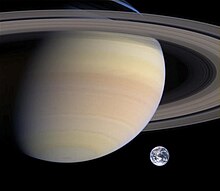
An aerobot is an aerial robot, usually used in the context of an unmanned space probe or unmanned aerial vehicle.
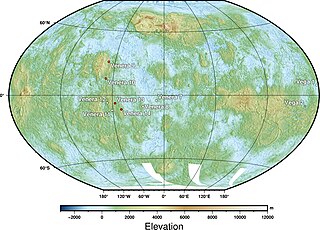
The Venera program was the name given to a series of space probes developed by the Soviet Union between 1961 and 1984 to gather information about the planet Venus.

Huygens was an atmospheric entry robotic space probe that landed successfully on Saturn's moon Titan in 2005. Built and operated by the European Space Agency (ESA), launched by NASA, it was part of the Cassini–Huygens mission and became the first spacecraft to land on Titan and the farthest landing from Earth a spacecraft has ever made. The probe was named after the 17th-century Dutch astronomer Christiaan Huygens, who discovered Titan in 1655.

Mars 96 was a failed Mars mission launched in 1996 to investigate Mars by the Russian Space Forces and not directly related to the Soviet Mars probe program of the same name. After failure of the second fourth-stage burn, the probe assembly re-entered the Earth's atmosphere, breaking up over a 320 km (200 mi) long portion of the Pacific Ocean, Chile, and Bolivia. The Mars 96 spacecraft was based on the Phobos probes launched to Mars in 1988. They were of a new design at the time and both ultimately failed. For the Mars 96 mission the designers believed they had corrected the flaws of the Phobos probes, but the value of their improvements was never demonstrated due to the destruction of the probe during the launch phase.

Aerocapture is an orbital transfer maneuver in which a spacecraft uses aerodynamic drag force from a single pass through a planetary atmosphere to decelerate and achieve orbit insertion.
The New Frontiers program is a series of space exploration missions being conducted by NASA with the purpose of furthering the understanding of the Solar System. The program selects medium-class missions which can provide high science returns.

The exploration of Uranus has, to date, been through telescopes and a lone probe by NASA's Voyager 2 spacecraft, which made its closest approach to Uranus on January 24, 1986. Voyager 2 discovered 10 moons, studied the planet's cold atmosphere, and examined its ring system, discovering two new rings. It also imaged Uranus' five large moons, revealing that their surfaces are covered with impact craters and canyons.

The ExoMars Trace Gas Orbiter is a collaborative project between the European Space Agency (ESA) and the Russian Roscosmos agency that sent an atmospheric research orbiter and the Schiaparelli demonstration lander to Mars in 2016 as part of the European-led ExoMars programme.
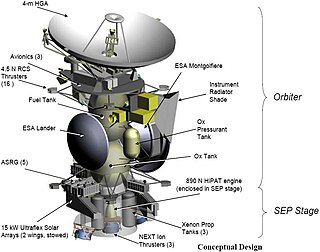
Titan Saturn System Mission (TSSM) was a joint NASA–ESA proposal for an exploration of Saturn and its moons Titan and Enceladus, where many complex phenomena were revealed by Cassini. TSSM was proposed to launch in 2020, get gravity assists from Earth and Venus, and arrive at the Saturn system in 2029. The 4-year prime mission would include a two-year Saturn tour, a 2-month Titan aero-sampling phase, and a 20-month Titan orbit phase.
Kronos is a concept mission to Saturn. It is aimed at detailed study of the chemical composition of Saturn's atmosphere, gravity and magnetic fields. The proposal consists of the solar powered carrier spacecraft, two atmospheric probes and (possibly) two small probes for the close-up imaging of the Saturnian rings.

The Planetary Science Decadal Survey is a serial publication of the United States National Research Council produced for NASA and other United States Government Agencies such as the National Science Foundation. The documents identify key questions facing planetary science and outlines recommendations for space and ground-based exploration ten years into the future. Missions to gather data to answer these big questions are described and prioritized, where appropriate. Similar decadal surveys cover astronomy and astrophysics, earth science, and heliophysics.

The Uranus Orbiter and Probe is an orbiter mission concept to study Uranus and its moons. The orbiter would also deploy an atmospheric probe to characterize Uranus's atmosphere. The concept is being developed as a potential large strategic science mission for NASA. The science phase would last 4.5 years and include multiple flybys of each of the major moons.
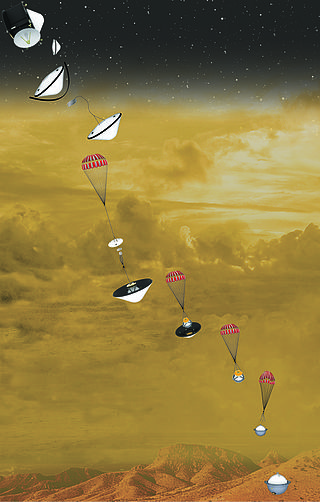
DAVINCI is a planned mission for an orbiter and atmospheric probe to the planet Venus. Together with the separate VERITAS mission, which will also study Venus, it was selected by NASA on 2 June 2021 to be part of their Discovery Program. Its acronym is inspired by Leonardo da Vinci in honor of his scientific innovations, aerial sketches and constructions.

Schiaparelli EDM was a failed Entry, Descent, and Landing Demonstrator Module (EDM) of the ExoMars programme—a joint mission of the European Space Agency (ESA) and the Russian Space Agency Roscosmos. It was built in Italy and was intended to test technology for future soft landings on the surface of Mars. It also had a limited but focused science payload that would have measured atmospheric electricity on Mars and local meteorological conditions.
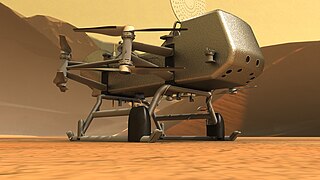
Dragonfly is a planned spacecraft and NASA mission to send a robotic rotorcraft to the surface of Titan, the largest moon of Saturn. It is planned to be launched in July 2028 and arrive in 2034. It would be the first aircraft on Titan and is intended to make the first powered and fully controlled atmospheric flight on any moon, with the intention of studying prebiotic chemistry and extraterrestrial habitability. It would then use its vertical takeoffs and landings (VTOL) capability to move between exploration sites.

SPRITE was a proposed Saturn atmospheric probe mission concept of the NASA. SPRITE is a design for an atmospheric entry probe that would travel to Saturn from Earth on its own cruise stage, then enter the atmosphere of Saturn, and descend taking measurements in situ.
Venus In Situ Atmospheric and Geochemical Explorer (VISAGE) is a proposed Venus lander mission that would perform atmospheric and surface science investigations.
Venus Origins Explorer (VOX) is a concept orbiter mission to Venus.

OCEANUS is a mission concept conceived in 2016 and presented in 2017 as a potential future contestant as a New Frontiers program mission to the planet Uranus. The concept was developed by the Astronautical engineering students of Purdue University during the 2017 NASA/JPL Planetary Science Summer School. OCEANUS is an orbiter, which would enable a detailed study of the structure of the planet's magnetosphere and interior structure that would not be possible with a flyby mission.

Neptune Odyssey is an orbiter mission concept to study Neptune and its moons, particularly Triton. The orbiter would enter into a retrograde orbit of Neptune to facilitate simultaneous study of Triton and would launch an atmospheric probe to characterize Neptune's atmosphere. The concept is being developed as a potential large strategic science mission for NASA by a team led by the Applied Physics Laboratory at Johns Hopkins University. The current proposal targets a launch in 2033 using the Space Launch System with arrival at Neptune in 2049, although trajectories using gravity assists at Jupiter have also been considered with launch dates in 2031.

